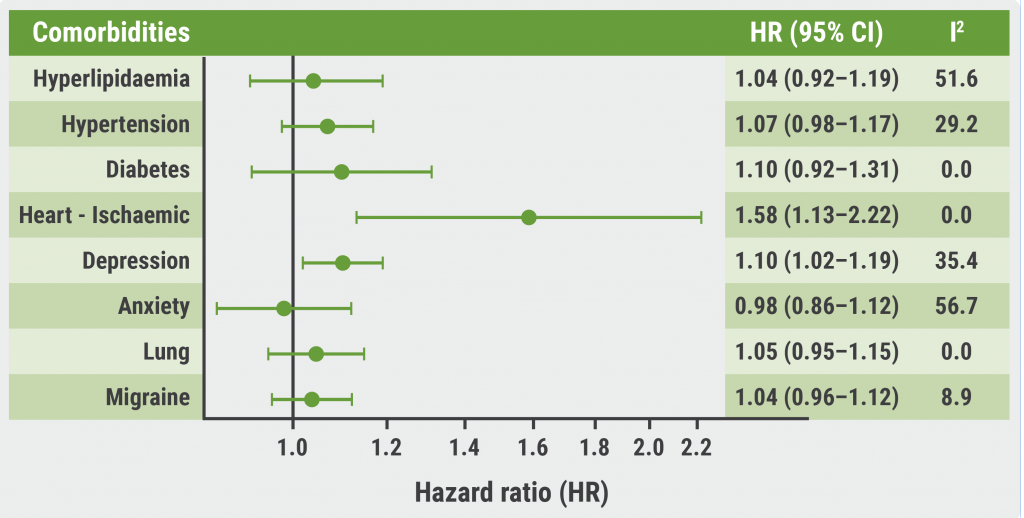https://doi.org/10.55788/15d11662
OCT is associated with future relapse risk in early MS. Therefore, it has emerged as a possible alternative for oligoclonal bands, which in turn were included in the 2017 revision of the McDonald diagnostic criteria for MS as a possible substitute for dissemination in time. Contrary to oligoclonal bands, OCT is not invasive and is therefore a more convenient option. A German research group further explored the use of OCT markers for early MS diagnosis [1]. They retrospectively analysed OCT data of 178 patients (120 women) who had a first demyelinating event suggestive of MS between 2011 and 2020.
At baseline, 134 (75%) patients fulfilled the 2017 McDonald criteria for relapsing-remitting MS. Over a mean follow-up of 4 years, 54 (30%) patients developed clinically definite MS. For conversion to clinically definite MS, the optimal cut-off value of peripapillary retinal nerve fibre layer (pRNFL) thickness in patients without optic neuritis was <98 µm, with a sensitivity of 0.72 and a specificity of 0.51. The optimal cut-off value for ganglion cell and inner plexiform layer (GCIPL) thickness was <68 µm, with a sensitivity of 0.68 and a specificity of 0.46.
Lower pRNFL (HR 2.30; 95% CI 1.30–4.00; P=0.003) as well as lower GCIPL (HR 2.1; 95% CI 1.20–3.60; P=0.008) thickness were associated with an increased clinically definite MS rate. This association was lacking with McDonald 2017 dissemination in time criteria including oligoclonal bands (HR 1.8; 95% CI 0.57–5.90; P=0.310), or criteria based on baseline MRI only (HR 1.3; 95% CI 0.73–2.30; P=0.387).
The authors concluded that retinal OCT markers, and GCIPL thickness in particular, hold promise for early MS diagnosis. OCT may improve MS diagnostic accuracy by identifying dissemination in time in patients who present without optic neuritis.
- Buenrostro GS, et al. Retinal optical coherence tomography markers for dissemination in time. P402, MSMilan 2023, 11–13 October, Milan, Italy.
Copyright ©2023 Medicom Medical Publishers
Posted on
Previous Article
« Early intensive treatment enhances long-term clinical outcomes Next Article
Breakthrough in Predicting MS Progression Through Genetic Testing »
« Early intensive treatment enhances long-term clinical outcomes Next Article
Breakthrough in Predicting MS Progression Through Genetic Testing »
Table of Contents: MSMilan 2023
Featured articles
Letter from the Editor
Real-world data supports ocrelizumab prior to conception
Progressive MS
Early initiation of highly active treatment associated with a lower risk of SPMS
Ocrelizumab more effective than interferon/glatiramer acetate in older MS patients
Paediatric MS
Prioritising high efficacy therapies in children with MS
Omega-3 polyunsaturated fatty acids associated with lower risk of MS activity
NMOSD & MOGAD
An update on evolving treatment algorithms for NMOSD and MOGAD
Women’s Health
Rate of grey matter brain atrophy accelerates after menopause
Real-world data supports ocrelizumab prior to conception
Miscellaneous
New insights into the contribution of EBV to MS pathogenesis
COVID-19 infection associated with higher MS relapse rate
Telerehabilitation effective in improving MS symptoms in patients with moderate disability
Curing MS
Understanding what an MS cure means and what it takes
Prodromal MS
Progressive brain tissue loss precedes the onset of clinical MS by years
Sickness absence rate increases years before clinical onset of MS
Treatment Trials and MS Strategies
Early intensive treatment enhances long-term clinical outcomes
Oral glycolipid shows promise in the treatment of MS, especially SPMS
Fenebrutinib shows rapid reduction of new Gd+ T1 lesions
Challenges of de-escalation versus discontinuation of highly effective DMTs in older MS patients
Biomarkers & Imaging
χ-separation can assess the effects of tissue destruction in early MS lesions
High sGFAP levels are associated with disease progression, independent of NfL or relapse activity
Broad rim lesions correlate with a rapidly progressive MS phenotype
Smouldering inflammation detectable even in the earliest stages of MS
Related Articles
August 18, 2021
Typing behaviour to remotely monitor clinical MS status

November 18, 2024
More comorbidity is associated with worse clinical outcomes in MS
December 16, 2020
Characteristics of a population-based MS cohort treated with DMDs
© 2024 Medicom Medical Publishers. All rights reserved. Terms and Conditions | Privacy Policy
HEAD OFFICE
Laarderhoogtweg 25
1101 EB Amsterdam
The Netherlands
T: +31 85 4012 560
E: publishers@medicom-publishers.com

